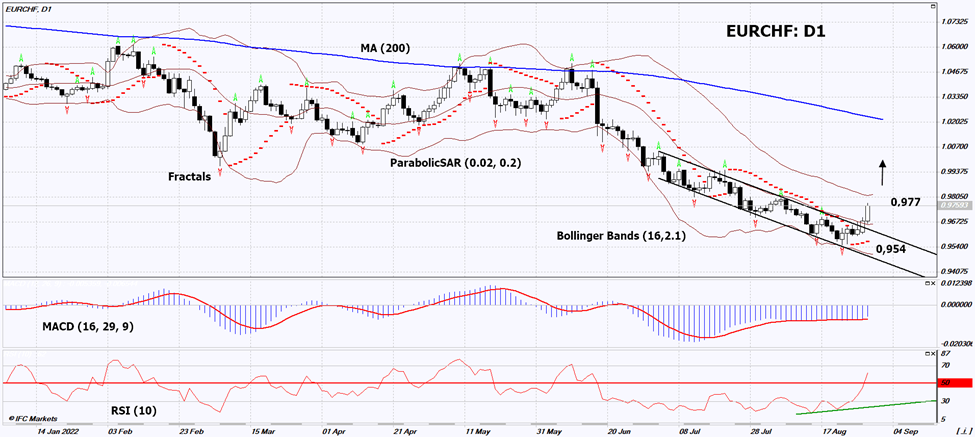EUR/CHF Technical Analysis Summary
Above 0,977
Buy Stop
Below 0,954
Stop Loss
| Indicator | Signal |
|---|---|
| RSI | Buy |
| MACD | Buy |
| MA(200) | Neutral |
| Fractals | Buy |
| Parabolic SAR | Buy |
| Bollinger Bands | Neutral |
EUR/CHF Chart Analysis
EUR/CHF Technical Analysis
On the daily timeframe, EURCHF: D1 went up from the downward channel. The currency pair is correcting upwards from the actual historical low, if we do not take into account the emotional collapse of the rate on January 15, 2015. A number of technical analysis indicators formed signals for further growth. We do not rule out a bullish movement if EURCHF: D1 rises above its most recent high of 0.977. This level can be used as an entry point. Initial risk cap is possible below the last down fractal and the Parabolic signal: 0.954. After opening a pending order, we move the stop following the Bollinger and Parabolic signals to the next fractal low. Thus, we change the potential profit/loss ratio in our favor. The most cautious traders, after making a trade, can switch to a four-hour chart and set a stop loss, moving it in the direction of movement. If the price overcomes the stop level (0.954) without activating the order (0.977), it is recommended to delete the order: there are internal changes in the market that were not taken into account.
Fundamental Analysis of Forex - EUR/CHF
Investors do not rule out a rate hike by the European Central Bank (ECB). Will the EURCHF quotes continue to rise?
ECB board member Isabel Schnabel said that central banks should fight high inflation despite the risks of a recession. Recall that in July the growth of the European Union Consumer Price Index reached a 40-year high and amounted to +8.9% y/y. The next meeting of the ECB will take place on 8 September. Investors believe that a rate increase of 0.75% from the current level of 0.5% to 1.25% is possible. In turn, the Swiss National Bank (SNB) meeting will take place on September 22, after the ECB. Inflation in Switzerland was 3.4% y/y in July, while the SNB rate is negative at -0.25%. Switzerland Consumer Price Index for August will be released on September 1st. Its further growth is expected, which may negatively affect the Swiss currency. Other significant economic data will be published this week in Switzerland: Switzerland Retail Sales and procure.ch PMI (September 1), as well as Employment Level (September 2). On Monday, September 5, data on GDP will be released. Note that inflation in the Eurozone for August will be released on August 31, and the trade balance of Germany and the producer price index in the EU on September 2. The combination of all these economic indicators will affect the EURCHF rate.
